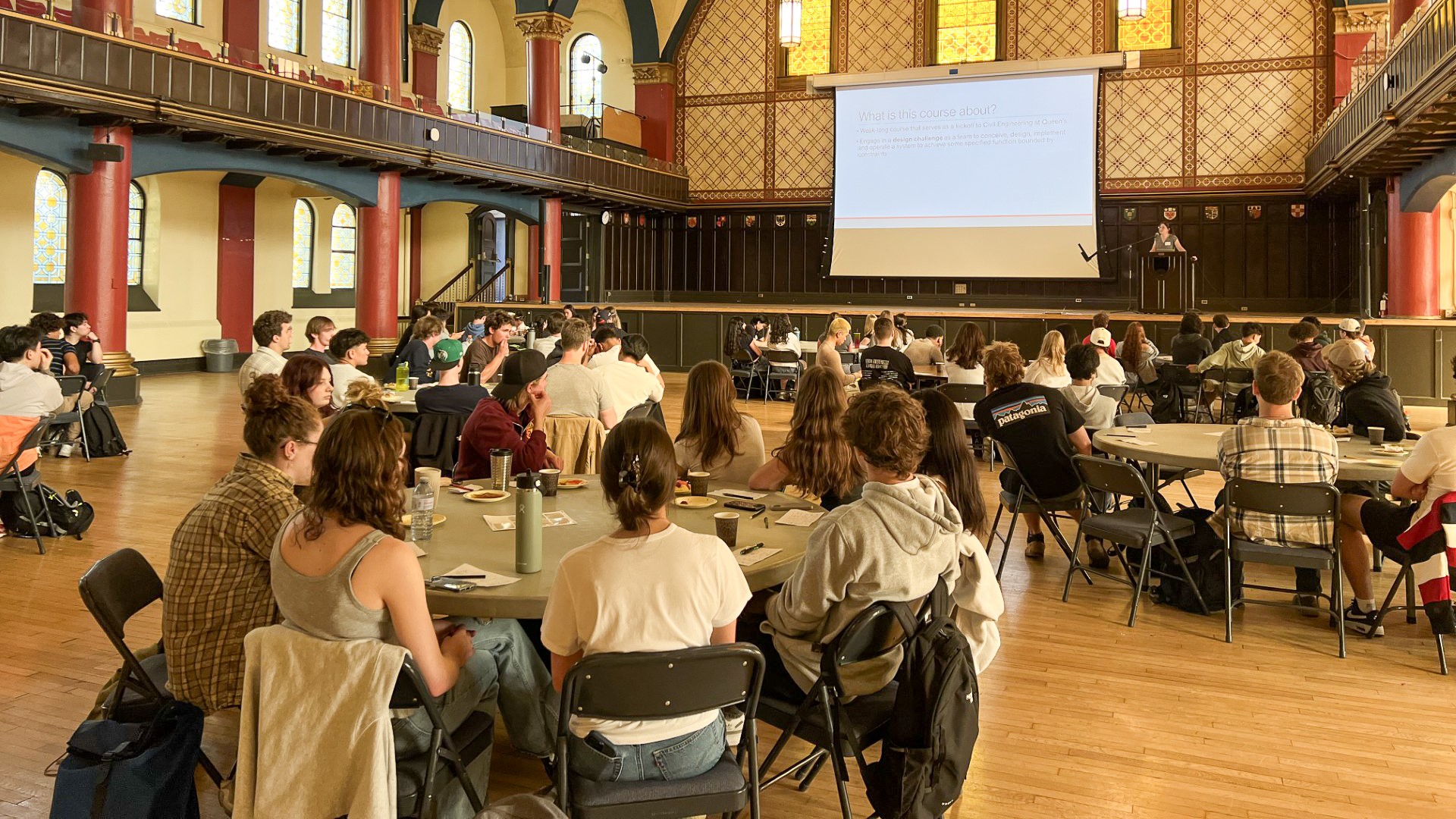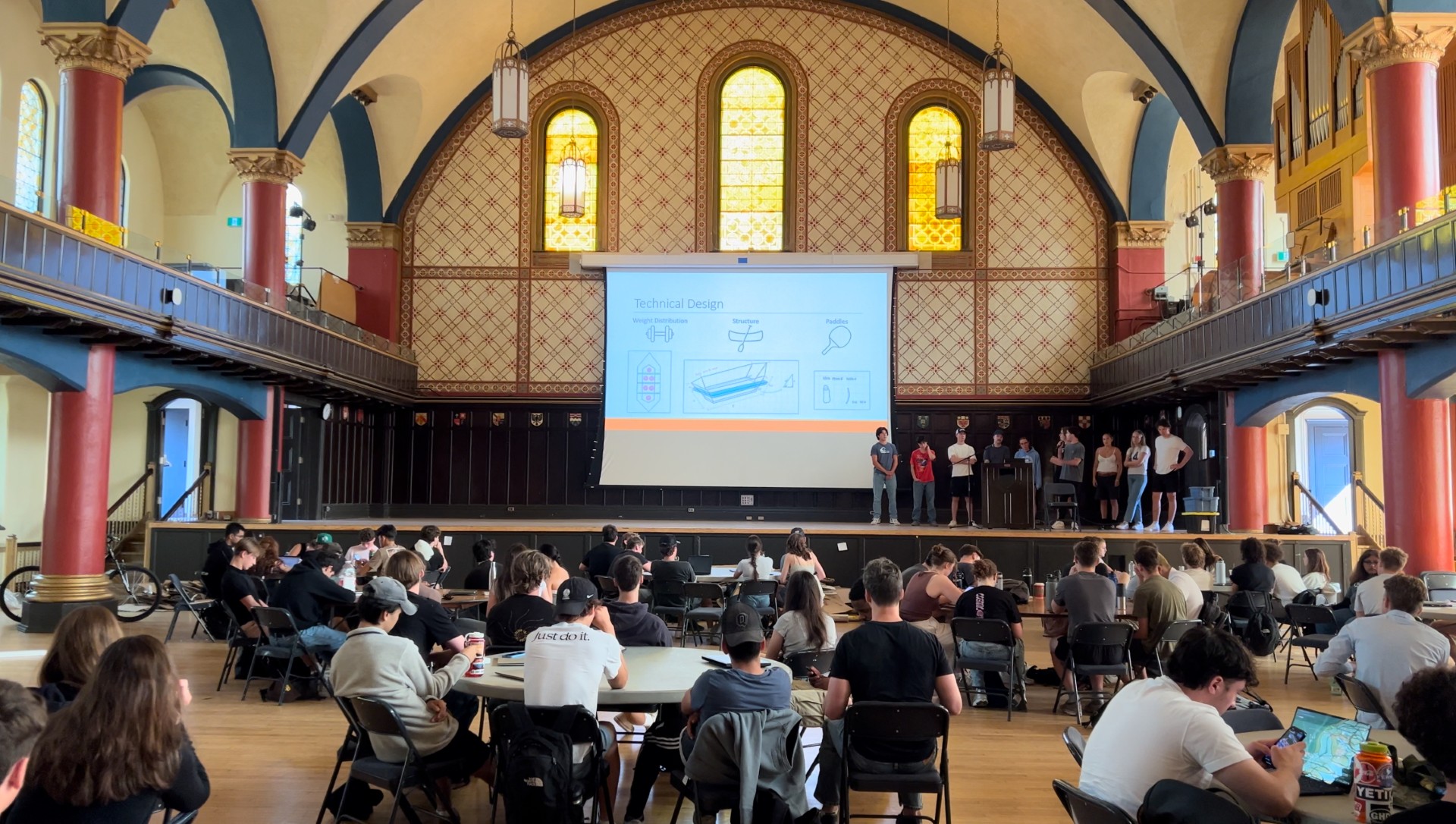Bright and early on the first day of classes this term, second-year Civil Engineering students gathered in Grant Hall for perhaps the grandest welcome of any discipline across Smith Engineering. Whereas most students across campus perused course syllabi and made perfunctory introductions, this group was immediately immersed in an intensive week of hands-on engineering design, teamwork, and community-building.
Civil 200 is a unique, weeklong course designed as an introduction for the students to the Civil Engineering department (following the common first year and discipline selection in the Winter term) that facilitates a hit-the-ground-running application of concepts inherent to the profession.

“It’s intended to be a very fun, welcoming, interactive week where students are meeting their new peers in the department,” says Stephanie Wright (Sc’16, PhD’21), the Assistant Professor in the Department of Civil Engineering who teaches and manages the course. “But they're also getting introduced to some of these design concepts that they're then going to apply in some of their faculty courses like APSC 200 and beyond.”
The idea is simple: in teams, students design and build a canoe made of cardboard. At the end of the week, each team launches its vessel on the Salmon River at the Department of Civil Engineering Kennedy Field Station to test its durability in a challenge of time and distance.
Teams are provided a request for proposals on the first day with defined criteria and constraints. Beyond satisfying durability, the teams are challenged to convince their client — in this case, a collective of faculty advisors and teaching assistants — that their design, as well as their team and their skills, are the best for the job.
It’s the process, and not so much the culminating event, that determines the students’ success in the course.
The mornings of Tuesday to Thursday were spent as seminars on professional skill elements such as technical writing, communication, teamwork, and leadership. And even they are hands-on activity based: the section on teamwork, for example, involves a learning-by-doing approach that exemplifies the process beyond the theoretical.
“We give them a challenge with 20 pieces of dry spaghetti, some string, and a marshmallow, and the challenge is to build the highest tower as a team,” says Wright. “We’re showing them the processes that inevitably come out in any kind of teamwork activity.”
The project is timely; at the start of the fall term, the surrounding area is blanketed with empty boxes from students moving onto campus and nearby.
As far as constraints in the request for proposals, teams must be able to transport six members and their equipment from point A to point B, a specific route on the river. For added complexity, the vessel should be environmentally friendly.
“There are scored points associated with how much of the materials that they're using are recyclable or not, or if they're just waste,” says Wright. “A lot of materials that might be nice to use for waterproofing like plastics and tarps are great, but they might not necessarily be the most environmentally friendly option. And so, they have to weigh those elements and constraints as it relates to the scoring of the final design proposal.”

At the end of the week, students, faculty and staff gathered at the Kennedy Field Station near Tamworth, a property donated in 2006 to the Department of Civil Engineering by a distinguished alumnus and former head of the department, Russell Kennedy, for the launch of the teams’ vessels.
“A lot of the times we find that not necessarily just one design fits the bill,” says Wright, regarding the variety of successful launches in past years. “It's really about how the vessel was constructed, the shape, the size, the material. There's a lot of different elements, so even if they think they might have a sense of what will work best, they really might have no idea in practice.”
“At the end of the day, we always have at least a handful of teams that can successfully complete the course on the river without their vessel falling apart. Of course, many boats end up collapsed in the river, even right at the very start.”
This year, Team 2 (Big Berta) and Team 5 (The Gators) came out with the fastest times, both with similar designs consisting of a wide solid base and pointed front wrapped with a tarp or plastic sheet. These teams faced off in an exciting final race with the entire civil class, faculty, staff, including Dean Kevin Deluzio, cheering them on, with Big Berta taking the final win.
By the close of the week, second year students of Civil Engineering have come to recognize the peers they’ll work alongside for the following three years through graduation. They’ll also have engaged with a number of the faculty and staff from the department.
“Every one of these teams has a faculty advisor who's helping them out,” says Wright. “Advisors meet with their team, watch and grade their presentations, and cheer them on at the finish line on Friday. While CIVL 200 is a really great way to get some design process flowing, it's also a great way of building community and spirit within our department.”